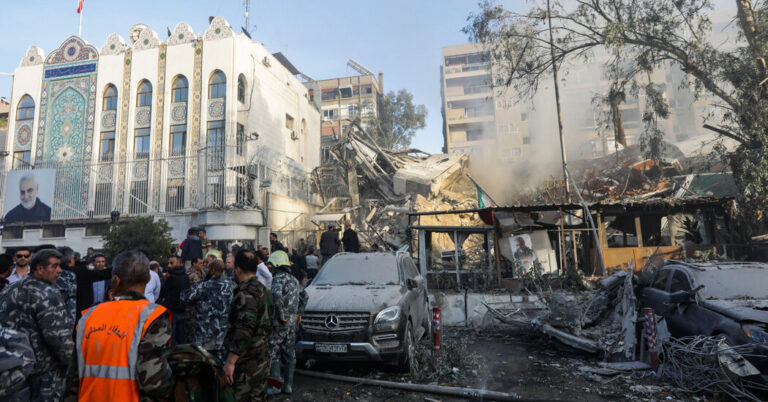For decades, Israel and Iran have fought a shadow of war in the Middle East, trading attacks by land, sea, air and in cyberspace.
Iran increasingly uses foreign proxies to strike Israeli interests, while targeted assassinations of Iranian military leaders and nuclear scientists are a key part of Israel’s strategy.
Israel’s strike on the Syrian capital, Damascus, that killed three top Iranian commanders on Monday was the most brazen attack in years, raising fears of a wider confrontation. That would be particularly dangerous in a region already in turmoil on many fronts, including Israel’s war on Gaza, cross-border skirmishes between Israel and the Lebanese militant group Hezbollah and attacks by Yemen’s Houthi militia. against Western interests in the Red Sea. Escalation between Israel and Iran would also risk further encroachment on the United States, given the presence of American troops in the region.
Here are some key moments in the years-long conflict.
January 2020: A major target
The killing of Maj. was met with joy in Israel. Gen. Qassim Suleimani, commander of Iran’s Islamic Revolutionary Guards Corps, during an American drone strike in Baghdad.
Iran retaliated by attacking two bases in Iraq housing American troops with a barrage of missiles, injuring about 100 US military personnel.
American officials have accused General Suleimani of causing the deaths of hundreds of soldiers during the Iraq war. They also said he was behind Iran’s destabilizing activities across the Middle East and that he was accused of planning attacks against US embassies and Israeli targets.
The general built a network of allied militias to defend Iran’s interests throughout the Middle East and to counter the United States and Israel.
October 2023: Tit-for-tat strike before October 7
Iran and Israel have reportedly carried out several covert attacks and attacks in the years following the death of General Suleimani.
Israel assassinated Iran’s top nuclear scientist, Mohsen Fakhrizadeh, in November 2021, followed by the assassination of a Revolutionary Guards commander, Col. Sayad Khodayee, in May 2022.
In July 2021, an oil tanker operated by an Israeli-owned shipping company was attacked off the coast of Oman, killing two crew members, according to the company and three Israeli officials.
Two of the officials said the attack appeared to have been carried out by several Iranian drones that crashed into the accommodation below the ship’s bridge. Iran has neither directly claimed nor denied responsibility, but a state-owned TV channel described the attack on the ship as a response to an Israeli strike on Syria.
As soon as Israel began bombing Gaza after the Hamas-led attacks on October 7, Iranian-backed militias stepped up their attacks.
December 2023: Another high-profile murder
At the end of last year, Iran accused Israel of killing a high-ranking military officer, Brig. Gen. Sayyed Razi Mousavi, in a missile strike outside Damascus. A senior advisor to the Revolutionary Guards, General Mousavi was described as a close associate of General Suleimani and said to have helped oversee arms shipments to Hezbollah.
Israel, adopting a customary stance, declined to comment directly on whether it was behind General Mousavi’s death.
January 2024: Back-and-forth attacks increased
The Pentagon launched a drone strike in Baghdad that killed a senior figure in a militant group linked to Iran.
The attack came days after an explosion in a suburb of Beirut, Lebanon, killed Saleh al-Arouri, a Hamas leader, along with two commanders from that group’s armed wing. The blast was the first assassination of a top Hamas official outside the West Bank and Gaza in recent years.
Officials from Hamas, Lebanon and the United States attributed the attack to Israel, which has not publicly confirmed its involvement.
Mr. al-Arouri is the most senior Hamas figure to be killed since Israel pledged to dismantle the organization after October 7.
Israel has been blamed for many attacks in Syria and Lebanon. In February, Syrian state news media said Israel was behind an airstrike on a residential building in Damascus that killed two people.
Israel’s military declined to comment on that strike, though it acknowledged hundreds of previous strikes on Iran-linked targets in Syria.
But the Israeli military acknowledged a strike in southern Lebanon in February that it said killed a Hezbollah commander, and in March, it killed a senior Hamas operative in an airstrike also in southern Lebanon.
March 2024: A tense atmosphere
An Israeli drone strike targeted a car in southern Lebanon, killing at least one person. Israel’s military says it has killed the deputy commander of Hezbollah’s rocket and missile unit. Hezbollah acknowledged the death of one man, Ali Abdulhassan Naim, but did not provide further details.
On the same day, airstrikes killed soldiers near Aleppo, northern Syria, in what appeared to be one of the heaviest Israeli attacks on the country in years.
Those strikes killed 36 Syrian soldiers, seven Hezbollah fighters and one Syrian from a pro-Iran militia, according to the Syrian Observatory for Human Rights, a Britain-based group that monitors Syria’s civil war.
The Israeli military has not claimed responsibility. However, the country’s defense minister, Yoav Gallant, wrote on social media, “We will pursue Hezbollah in every area it operates and we will increase the pressure and the speed of the attacks.”
Three days later, on Monday night, Israeli warplanes struck the building in Damascus in an attack that killed three top Iranian commanders.
